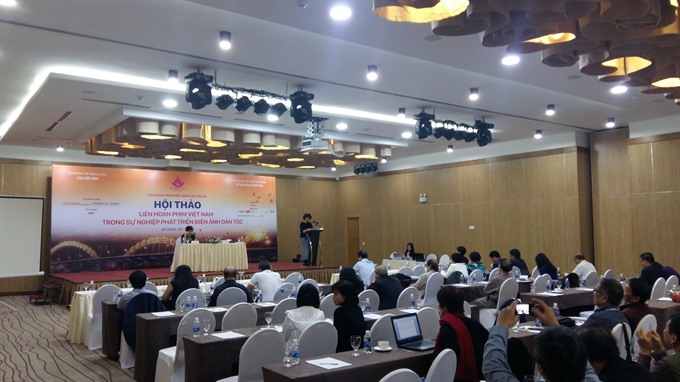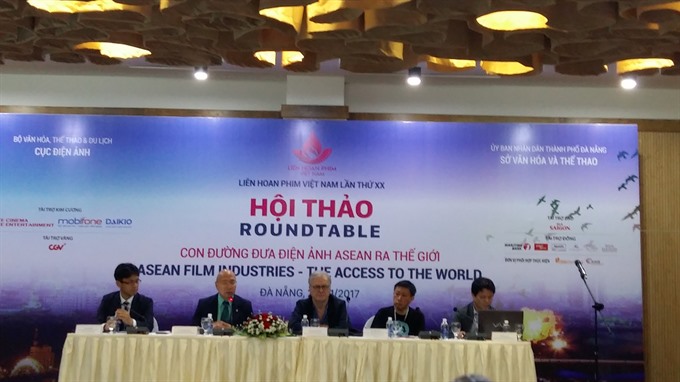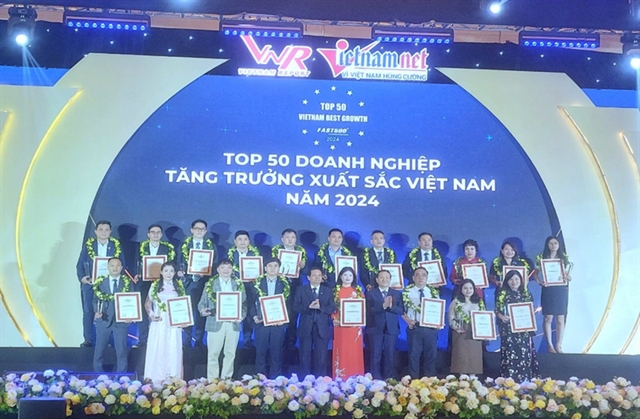 Life & Style
Life & Style

The state-supported film industry, once the “pride of Việt Nam,” has fallen victim to shrinking budgets and rising commercialism, Vice Chairwoman of the Việt Nam Cinematography Association Nguyễn Thị Hồng Ngát lamented yesterday at a seminar on the development of national cinema, held alongside the 20th Việt Nam Film Festival.
 |
| Strong attendance: More than 200 film directors, writers and officials took part in seminars during the 20th Vietnamese Film Festival in Đà Nẵng city. — VNS Photo Công Thành |
ĐÀ NẴNG — The State-supported film industry, once the “pride of Việt Nam,” has fallen victim to shrinking budgets and rising commercialism, Vice Chairwoman of the Việt Nam Cinematography Association Nguyễn Thị Hồng Ngát lamented yesterday at a seminar on the development of national cinema, held alongside the 20th Việt Nam Film Festival.
Ngát noted that this year’s festival was marred by the absence of two illustrious State-owned film firms, the Việt Nam Feature Film and Giài Phóng (Liberation) Film, for the first time in its 20 years.
“Traditionally famous film producers and directors have gradually disappeared from the biggest national festival in recent years,” Ngát said. “The lack of State budget resources partly prevented the development of traditional film industry that was once the pride of Việt Nam over the industry’s 65-year history,” Ngát said.
Ngát, who is vice chairwoman of the Feature Film Assessment Council, also expressed her worry that the country’s films are low quality. Poorly written comedies, horror films and romances abound, while more substantive themes like history and the war resistance struggle of the Vietnamese people are ignored. While Việt Nam has developed, the film industry remains focused on short-term profits, she said.
Film writer Đoàn Minh Tuấn said the lack of State funding for film advertisement prevented Việt Nam’s film industry from promoting itself among local audiences and abroad. He noted that while the Ministry of Finance allocated funds for film production, there was no funding for marketing, which can sometimes cost three times as much as the production itself.
Vice rector of Việt Nam College of Cinematography and Stage Nguyễn Thị Thu Hà suggested that the festival should reserve a prize for young film directors or current students. Hà said young students had relatively few options for scholarships and prizes to get financial support for their efforts to make short films.
Director Tô Hoàng said that the State fund for the film industry was somewhere in the billions of Vietnamese đồng, lower than the cost of building a kilometre of road, he claimed.
“The film industry needs support from the State fund in promoting traditional film, while the private sector can invest in entertainment and commercial films,” Hoàng said.
Too many Vietnamese films, he argued, are produced by poorly educated film makers and contain gratuitous sex and violence.
Ngô Thanh Vân, director of the new film Cô Ba Sài Gỏn, or The Tailor, said that local film producers have faced a financial crunch resulting from decreased ticket prices and weak copyright enforcement.
She said many cinemas have reduced ticket prices to lure viewers, while the Government has not strongly prevented copyright infringement.
Vân said audiences seemed to applaud violations of film copyright.
“My film, which was illegally recorded at the cinema, was watched by 6,000 viewers as soon as it was posted online,” Vân said.
Access to the world
Also on the occasion of the 20th Vietnamese Film Festival, film experts from ASEAN, South Korea and Poland joined a round-table discussion on ASEAN film industries’ access to global audiences.
Yun Ha, director of the future strategy division under the Korean Film Council (KOFIC), said Việt Nam and South Korea can establish links between the film industries of the two countries by promoting each other’s films in the coming years.
“Many Korean films have brought to Việt Nam, and Vietnamese films can be taken to Korea. For example, the Vietnamese movie Em Chưa 18 (Jailbait) was introduced in Korea,” Yun Ha said.
He added that KOFIC could help bring the film production of Việt Nam and ASEAN to South Korea and the world, while also supporting joint film production.
Deputy Secretary General of ASEAN for Socio-Cultural Community Vongthep Arthakaivalvatee said film makers and directors from ASEAN can cooperate to build the ASEAN film community. ASEAN members can also learn about each other’s identities through the medium of film.
Đỗ Duy Anh, deputy head of the Việt Nam Cinematography Department, said the ASEAN film industry has developed independently within each member economy, but there have been discussions about how to unify development.
Anh said quality of ASEAN films is uneven and the region needs more good film products to compete at the world level.
He said Việt Nam, which produces 40 films per year, sends around 30 films to international film festival annually, illustrating the potential of the country’s film industry.
“The country’s film industry has 628 cinemas with 95,000 seats. Of this, foreign companies including CGV and Lotte hold 70 per cent market share, earning $150 million per year,” Anh said.
“We can cooperate on film distribution and production via the ASEAN Fund. We should set up booths to introduce our films at Cannes Film Festival or Berlin fashion film festival,” Anh said, adding that ASEAN should seek more private sector funding to promote its film industry on the world stage.
Director Hồng Ánh, whose film Island of Aliens won three awards at a festival in Malaysia in May, said her film was a successful story of Vietnamese creative leadership and international cooperation.
“We could say that 80 per cent of the work on our film was Vietnamese, while the rest came from experts from France. Our film received much support from the ministry of Culture, Sports and Tourism of Việt Nam,” Ánh said.
“We try to tell a universal story, but it must include the identity of Việt Nam and the ASEAN style in combination with international technical expertise.”
The 20th Vietnamese Film Festival, which has drawn more than 800 film makers, directors, actors, actresses and film writers from across ASEAN, will continue today and tomorrow with outdoor screenings and exchanges between audience members and film makers, actors and actresses.
The national film award winners will be announced on November 28th. — VNS
 |
| Korean screens: Trailer of Em Chưa 18 (Jailbait), a Vietnamese film released in Korea. — Photo courtesy Vietnamese Film Festival |
 |
| Go global: Participants from cinema associations from ASEAN, Poland, South Korea and Việt Nam join a seminar on how to bring ASEAN film to the world in Đà Nẵng. — VNS Photo Công Thành |









